With the myriad of benefits of cloud-based communication and productivity & collaboration abilities, the migration of Office 365 is demanded by an increasing number of businesses. Several Office 365 migration types ensure zero headaches or frustration during the migration to the new platform from the old. Office 365 migration plan is also helpful in the migration of selected data in a very secure manner.
Four Office 365 Migration Types
There are multiple ways by which one can exercise Office 365 migration. Let us discuss the four main types of Office 365 Migration so that you can know everything you need to know for a successful migration without any follies or pitfalls.
1. Staged Migration
It allows the movement of data in batches. It covers mailboxes & existing users to Exchange Online from Exchange 2003 or 2007. This type is ideal for a medium-sized organization having more than 2000 mailboxes.
- Not available for migration from Exchange 2010 or 2013
- Mailboxes are moved in batches over a pre-specified time frame
- Emails can be sent and received during the migration (only for users, whose migration is not done)
- Calendars and delegates features are not available during the migration
2. Cutover Migration
This Office 365 Migration Type involves an immediate transition to Office 365. In this, the contacts, mailboxes, and other resources are migrated in one instance. The selection of specific parameters for migration is not available.
- Suitable for migration from Exchange 2003, 2007, 2010 or 2013
- Ideal for less than 2000 mailboxes.
- Every user profile will require reconfiguration for connecting to Office 365
3. Hybrid Migration
The Office 365 hybrid migration involves integrating Office 365 with the on-premises Exchange Servers PLUS your existing directory services. In both environments, user accounts can be managed and synchronized.
- Suggested for over 2000 mailboxes
- Option to select mailboxes for migrations
- Passwords can be synchronized with the initiation of a single sign-on to the team
- Exchange 2010, Exchange 2013, or Exchange 2010 Service Pack 3 (SP3) server must be compulsorily installed on-premises
4. IMAP Migration
The previous 3 Office 365 migration types require ‘Exchange.’ However, this IMAP migration, in particular, permits users to transition from email systems supporting IMAP migrations like Gmail. It transitions only to email, hence calendar items, and contacts are not migrated automatically. The user for this requires manual action.
- Before starting, compulsory create a mailbox for every user
- The total mailboxes limit and items limit is 50,000 and 5,000,000, respectively
- After migration, there will be no migration of new emails sent to the original mailbox
Professional O365 Consulting and Migration Assistance
If you want expert guidance, consultation, and help with your Office 365 migration needs, you can contact the experts at CloudCodes. To date, they have assisted tons of organizations with their Office 365 migration requirements. They have the expertise, experience, and knowledge to make you move ahead without interruption of daily activities.

